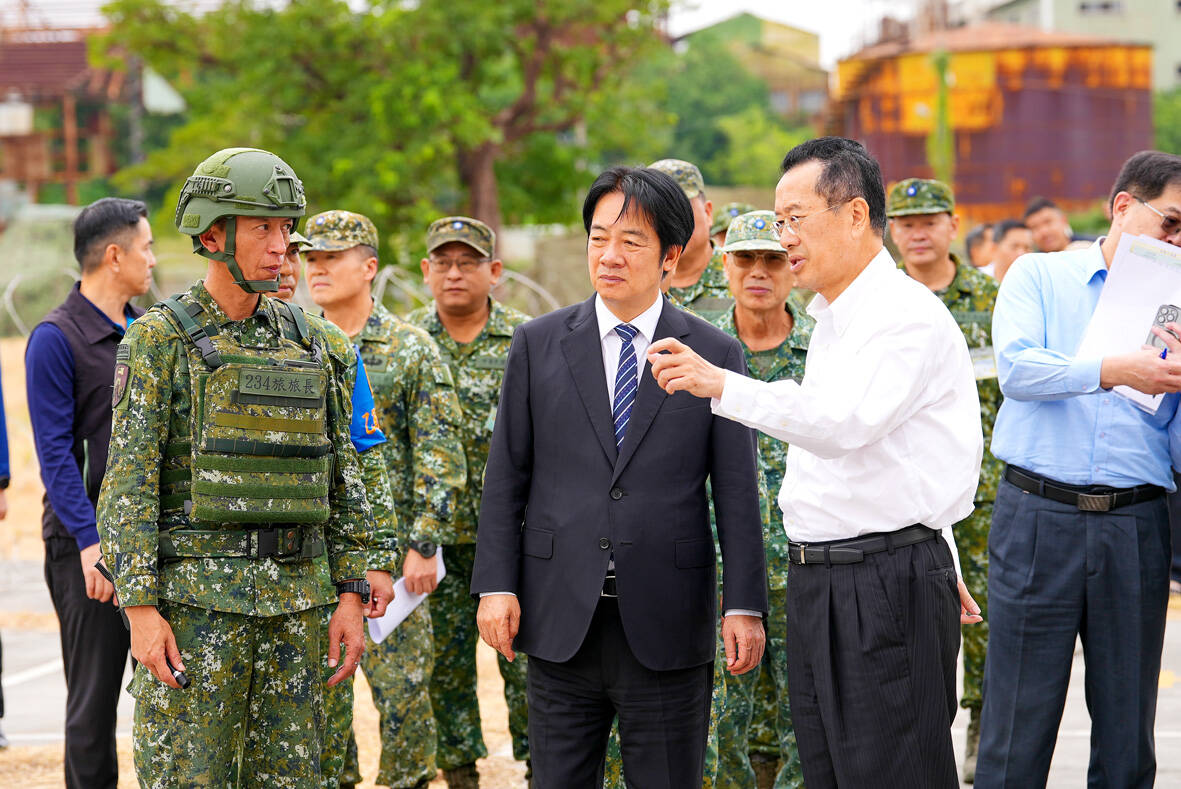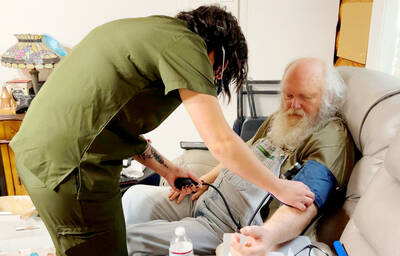Is there an equilibrium in Taiwan politics, or what Oxford defines as “A state in which opposing forces or influences are balanced”? If there is, what is it, and what could change it?
Pattern recognition is a crucial aspect of political analysis. Correctly spotting and identifying changing or emerging trends can prove an analyst prescient.
It also presents dangers, and can show an analyst is a fool. There are at least two ways this can happen: Incorrectly identifying the causes of a trend or overextrapolating a trend beyond where it is going.

Photo courtesy of the Presidential Office
Some analysts predicted that Chinese Communist Party (CCP) Secretary-General Xi Jinping (習近平) would be ousted at the recently concluded fourth plenum. It appears their eagerness to be right, and probably a large dose of wishful thinking, led those analysts off a cliff.
ROUGH EQUILIBRIUM
In recent years, there has been a rough equilibrium between parties. Yet polling in recent months has been volatile.
Are we undergoing a major shift? Has exhaustion with nearly 10 years of Democratic Progressive Party (DPP) rule caught up with them, as usually happens in democracies?
Could the dominance at the local level by the Chinese Nationalist Party (KMT) be cracking, or could the Taiwan People’s Party (TPP) change the calculus?
In a recent column (“A different way of analyzing recent election results in Taiwan,” Sept. 20, page 12) we examined how voting results in local elections were nearly identical in local elections in 2018 and 2022, and in legislative elections in 2020 and last year — despite very different outcomes.
In 2022, the KMT won by a slightly higher 50.1 percent of the total popular vote compared to 48.8 percent in 2018. The DPP’s vote was also similar, at 39.7 percent in 2018 and 41.6 in 2022.
Despite not winning more city and council leadership races, 2022 was a great year for the KMT, winning big prizes like Taipei, Taoyuan and Keelung.
In constituency legislative voting, the DPP won 45.11 percent of the total vote in 2020 and 45.09 last year, dropping only .02 percent. The KMT won 40.71 percent in 2020, and even dropped to 39.96 last year.
The DPP actually increased their vote in the party list proportional representation legislative vote last year at 36.16 percent, up from 33.98 in 2020. The KMT got 33.36 in 2020 and 34.58 percent last year.
For the KMT, last year was a big win despite winning fewer votes, gaining 14 legislative seats. The typical narrative is that the tide was turning toward the KMT, but those wins were not due to more votes, but rather better get-out-the-vote campaigns in key races — likely due to KMT Chairman Eric Chu’s (朱立倫) effective strategic choices.
The presidential races can not be easily compared because last year was a three-way race, and it would likely have been closer than in 2020. However, in a previous column, we examined how William Lai (賴清德) still had the advantage in a two-way race.
THE RULING PARTY
The big immediate question facing the DPP is whether the damage inflicted by their disastrous decision to back the recall campaigns will last.
For roughly four years until June of this year, Formosa polling on the DPP has been fairly stable, with favorability averaging in the mid-40 percent range, with unfavorability roughly similar.
Similarly, confidence in former president Tsai Ing-wen (蔡英文) and current President Lai over the same time period averaged from the upper-40s to mid-50s, while satisfaction with their administrations was in the mid-40s to mid-50s. Their positive polling put them well above water compared to negative polling.
The continuity between the Tsai and Lai administrations is not surprising; Lai ran and won on continuing Tsai’s path.
That changed dramatically in June, putting them well underwater on all three metrics and showing the worst results by far for the DPP and president since 2019. DPP favorability plunged to the low 30s during the recall season, satisfaction with Lai’s administration dropped to a low of 31 percent in August, while confidence in the president hit 36 percent.
Yet, since hitting bottom in August, the DPP has been rising in the polls — but has only recovered over half of what they lost. Other polls show a similar trend, with some even showing the DPP having returned to the lower end of their long-term range.
THE OPPOSITION
The KMT’s favorability has been far more variable, ranging for years in the mid-20s to upper-30s. In the last few months, they have been in the higher end of that range, but have been higher several times within just the last year.
Broadly speaking, other polls confirm the trend of the KMT receiving a boost of a few percentage points in the late summer, but not outside of their long-term range. There does not appear to be any major trend moves on the KMT side.
The TPP is an interesting case. Their long-term favorability range was in the low to mid 30s, but plunged to the low 20s when party founder and then-party chairman Ko Wen-je (柯文哲) found himself facing a slew of legal issues, and was arrested on charges of corruption in August and September last year.
Under the leadership of Huang Kuo-chang (黃國昌), the TPP proved they were not a Ko one-man band, as many had speculated, but he was only able to bring favorability back up to the upper 20s, and appeared stuck roughly five percent lower than the previous long-term trend.
The recalls gave the TPP a boost, having returned to their previous low to mid 30s range since, even briefly topping the DPP in August.
QUESTIONS REMAIN
It is not surprising that the DPP and Lai are recovering from their lows, but the question remains whether they will return to the previous equilibrium, or if they have lost the support of five or even 10 percent of the population for the foreseeable future.
If the trend line continues, they will return to equilibrium, but it may yet stall out. Likely this will become clear in the next few months.
The big question for the KMT is the reaction to incoming Chairwoman Cheng Li-wun (鄭麗文). Her energy and charisma could boost favorability, her hardcore ideology could do the opposite or she could fade into the background, concentrating on the day-to-day job of running the party and not leaving much of an impression at all. Her character comes across as being more proactive, however.
The TPP could be facing two big tests in the coming months. Ko’s trial should wrap up, possibly as soon as December or January.
Meanwhile, Huang is facing allegations of forming an alleged “political surveillance” “paparazzi” group. He currently faces no charges and has not been arrested, but that could change.
If Ko is found guilty of corruption, will that damage the party? And what if Huang is arrested? Or both?
The latest Z.media poll asked if the allegations against Huang were true, would you approve or not approve, and even 58.7 percent of TPP respondents said “disapprove” and only 24.7 percent approved — though this result had a small sample base.
The current political environment is unstable. The legislative and executive branches are at each other’s throats, the CCP is ramping up its military threat level and foreign relations are in a choppy period, especially with the US.
This appears to be a period primed for big shifts, but the data is not indicating that.
Yet.
Donovan’s Deep Dives is a regular column by Courtney Donovan Smith (石東文) who writes in-depth analysis on everything about Taiwan’s political scene and geopolitics. Donovan is also the central Taiwan correspondent at ICRT FM100 Radio News, co-publisher of Compass Magazine, co-founder Taiwan Report (report.tw) and former chair of the Taichung American Chamber of Commerce. Follow him on X: @donovan_smith.

Oct. 27 to Nov. 2 Over a breakfast of soymilk and fried dough costing less than NT$400, seven officials and engineers agreed on a NT$400 million plan — unaware that it would mark the beginning of Taiwan’s semiconductor empire. It was a cold February morning in 1974. Gathered at the unassuming shop were Economics minister Sun Yun-hsuan (孫運璿), director-general of Transportation and Communications Kao Yu-shu (高玉樹), Industrial Technology Research Institute (ITRI) president Wang Chao-chen (王兆振), Telecommunications Laboratories director Kang Pao-huang (康寶煌), Executive Yuan secretary-general Fei Hua (費驊), director-general of Telecommunications Fang Hsien-chi (方賢齊) and Radio Corporation of America (RCA) Laboratories director Pan

President William Lai (賴清德) has championed Taiwan as an “AI Island” — an artificial intelligence (AI) hub powering the global tech economy. But without major shifts in talent, funding and strategic direction, this vision risks becoming a static fortress: indispensable, yet immobile and vulnerable. It’s time to reframe Taiwan’s ambition. Time to move from a resource-rich AI island to an AI Armada. Why change metaphors? Because choosing the right metaphor shapes both understanding and strategy. The “AI Island” frames our national ambition as a static fortress that, while valuable, is still vulnerable and reactive. Shifting our metaphor to an “AI Armada”

The older you get, and the more obsessed with your health, the more it feels as if life comes down to numbers: how many more years you can expect; your lean body mass; your percentage of visceral fat; how dense your bones are; how many kilos you can squat; how long you can deadhang; how often you still do it; your levels of LDL and HDL cholesterol; your resting heart rate; your overnight blood oxygen level; how quickly you can run; how many steps you do in a day; how many hours you sleep; how fast you are shrinking; how

“‘Medicine and civilization’ were two of the main themes that the Japanese colonial government repeatedly used to persuade Taiwanese to accept colonization,” wrote academic Liu Shi-yung (劉士永) in a chapter on public health under the Japanese. The new government led by Goto Shimpei viewed Taiwan and the Taiwanese as unsanitary, sources of infection and disease, in need of a civilized hand. Taiwan’s location in the tropics was emphasized, making it an exotic site distant from Japan, requiring the introduction of modern ideas of governance and disease control. The Japanese made great progress in battling disease. Malaria was reduced. Dengue was